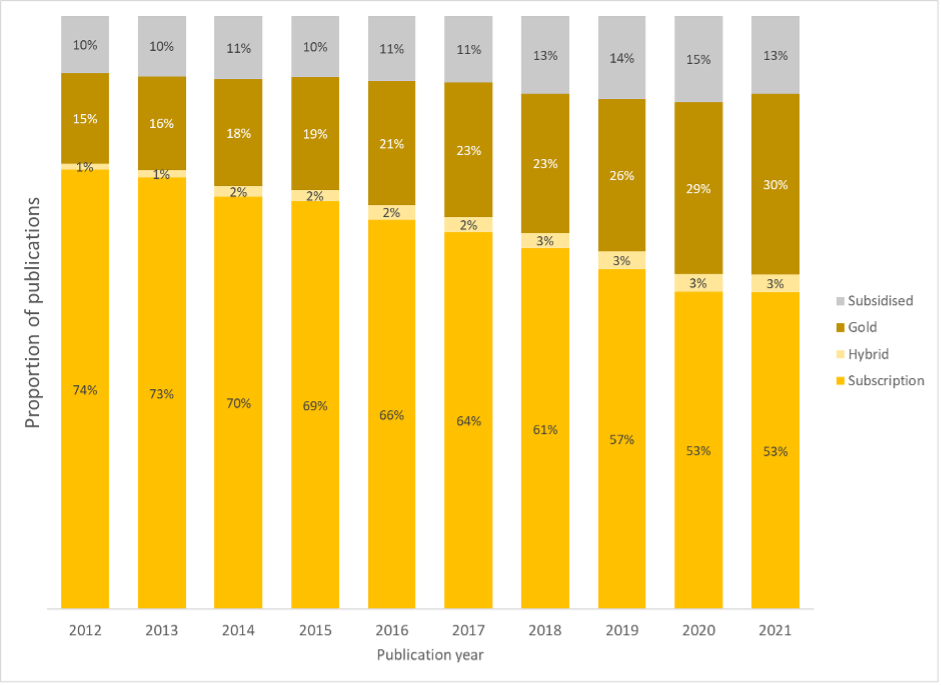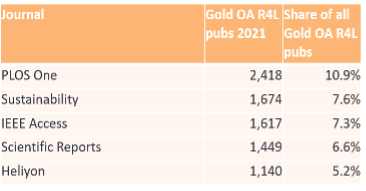Achieving an equitable transition to OA for researchers in the Global South: Latest findings
By Rachel Herbert, Senior Research Evaluation Manager, International Center for the Center of Research, Elsevier and Sarah Phibbs, Director, Research4Life Publisher Partnerships
Back in July 2020, Rob Johnson, Andrea Powell and Rachel Herbert published a white paper on how the transition to Open Access could be more equitable amidst concerns that publication barriers simply transition from one point to another. This update gives the latest picture of how authors affiliated to countries eligible for Research4Life are choosing Open Access when publishing their research.
OVERALL PUBLICATION GROWTH: The good news is that Research4Life author* output is speeding up with 17% compound annual growth rate (CAGR) in the last five years compared with 12% over the past 10 years. This compares with a global output growth rate of 7%. As a share of all publications, Research4Life authors are now contributing 7%; the growth is mainly driven by the overall number of Research4Life authors, encouragingly tripling in 10 years.
COUNTRY STORIES: More than 30 Research4Life countries published upward of 1000 papers in 2021, with 30% of all output attributable to Pakistan, Egypt and Ukraine. Iraq, Vietnam and Ethiopia saw high rates of output growth. Equally, growing output is newly seen in Nigeria, Bangladesh and Morocco.
OPEN TRENDS: The majority of Research4Life publications are published in journals under a subscription model. For OA week, we wanted to share the OA growth trend: 47% (all types of immediate OA) for 2021 compared with 24% in 2011. 33% are author-pays OA (in gold and hybrid journals) as compared to 28% for all Scopus-indexed publications in the same year, thereby bucking the trend.
WAIVER SUCCESS?: The vast majority of Research4Life OA publications are published in Gold journals (author-pays only), often with waivers or reductions when funding or corresponding author (CA) is based in Research4Life countries. Hybrid uptake, where waivers are less common, remains low at around 3%, similar to current estimates across Scopus®.

OA DRIVERS: Geographic uptake of Gold Open Access among Research4Life authors might give us a clue to models that are working. The highest contributions of Gold OA publications in 2021 came from Pakistan (15%) and Egypt (14%). Ethiopia, Nigeria and Vietnam all contributed more than 5%, with the balance distributed among remaining Research4Life eligible countries. The increased uptake of Gold OA could suggest improvements in journal or publisher policies for Research4Life authors or in country-based funder practices. The top 5 journals for 2021 output are included below, showing a trend towards broad/mega journals. APC policies vary across even between these few journals: some waive the APC dependent on the location of the corresponding author, others on the source of the funding, some are less clear, at least in the information available online. Given the common, if inconsistent requirement for the Corresponding Author to be based in a Research4Life country, it’s interesting to note that of all Research4Life 2021 publications, 68% have an Research4Life corresponding author (14% from Group A and 54% from Group B). Overall, this accounts for 5% of all publications published in Scopus in 2021. Journals are also taking other steps: increasing representation on editorial boards or editorial roles from Research4Life countries and implementing double-anonymized peer review to help tackle bias.

WHAT NEXT? The original white paper resulted in an Research4Life OA taskforce which developed Publisher Best Practices for APC waivers and an Index of links to waiver programmes to help authors navigate this complex landscape. But we can do better. Only approximately 35 publishers are listed today. But overall, the question is whether this model is workable for all LMIC authors. The diamond model often fills a gap but how sustainable is it really? At the recent Frankfurt STM Conference, Ana Heredia highlighted the need to balance diamond OA with transformational deals and to ensure greater inclusion of multilingual Latin American and Caribbean journals. We need to reflect multilingualism in our indexing databases to ensure we can drive for diverse and rich scholarly exchange. Our ambition for the new Research4Life Strategic Plan is to transform from one way donation to reciprocal engagement, ultimately to enrich future research quality and direction. We welcome a conversation to understand better how Research4Life can help and to identify areas of future research that we could commission to drive equity.
*’Research4Life authors’ are those associated with Research4Life-eligible countries, and ‘Research4Life publications’ with a minimum of one Research4Life author based on Scopus® with broad scholarly publication global coverage: 84m records, 7k publishers, 94k affiliation profiles, though with limitations that the criteria for titles and abstracts be written in English.





